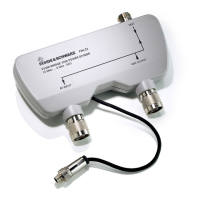R&S
®
CMW 500 GSM Applications
GSM TX Measurements
Operating Manual 1202.3986.32 – 03 208
Statistics
Statistical evaluation of the in the measurement slot. The "Statistics" table contains
four rows. For each modulation result the values are calculated as follows:
95
th
percentile: Value of the measured quantity below which 95 % of all
observations fall. An EVM 95
th
percentile of 0.8 indicates that 95 % of all measured
EVM results were below 0.8, 5 % equal to or larger than 0.8.
Current: Value of the modulation result obtained in the last measurement interval.
For EVM, magnitude and phase error, a current RMS result (the average over all
samples in the "Measured Slot" except the guard period) and current peak value
(the peak of all samples the preappointed slot except the guard period) is
available.
Avg.: Average of all "Current" values referenced to the last statistics cycle.
Min./Max.: Largest or smallest "Current" value that the R&S CMW 500 obtained
since the start of the measurement.
Std. Dev.: Standard deviation of all "Current" values since the start of the
measurement.
The results in the table are calculated according to the general rules for statistical
evaluations.
The timing error is not available for untriggered ("Free Run") measurements.
Results in the "Statistics" table:
The EVM, magnitude error, phase error, I/Q offset and I/Q Imbalance describe the
modulation accuracy of the measured uplink GSM signal; see modulation results. The
frequency error is determined together with the modulation results. The multi-
evaluation measurement provides the following additional quantities:
Timing Error: Difference between the actual timing of the slot and the expected
timing. The actual timing is given by the training sequence. The expected timing is
derived from the detected frame timing, therefore the "Timing Error" measurement
requires an internal trigger (trigger source "IF Power (Internal)" or "Acquisition
(Internal)").
Bust Power: Average burst power, evaluated over the useful part of the burst (see
standard 3GPP TS 51.010-1).
AM PM Delay: Time delay of the amplitude vs. time trajectory of the baseband
modulation vector relative to the phase vs. time trajectory that is need to minimize
the modulation errors (EVM). The AM PM delay is a characteristic quantity for
polar modulation schemes which make use of polar coordinates (amplitude and
phase) rather than Cartesian coordinates (I and Q amplitudes).
The detailed dialogs can be modified as follows:
Press "Display > Trace Select..." to select the trace types to be displayed. Use the
scale settings to modify the displayed x-axis (time) or y-axis ranges.
Use the "Measurement Control" settings in the configuration menu to modify the
scope of the measurement, change the "Measurement Slot", and select the offset
frequencies for the spectrum diagrams.
Use the "Filter" settings in the configuration menu to select the filter bandwidth for

